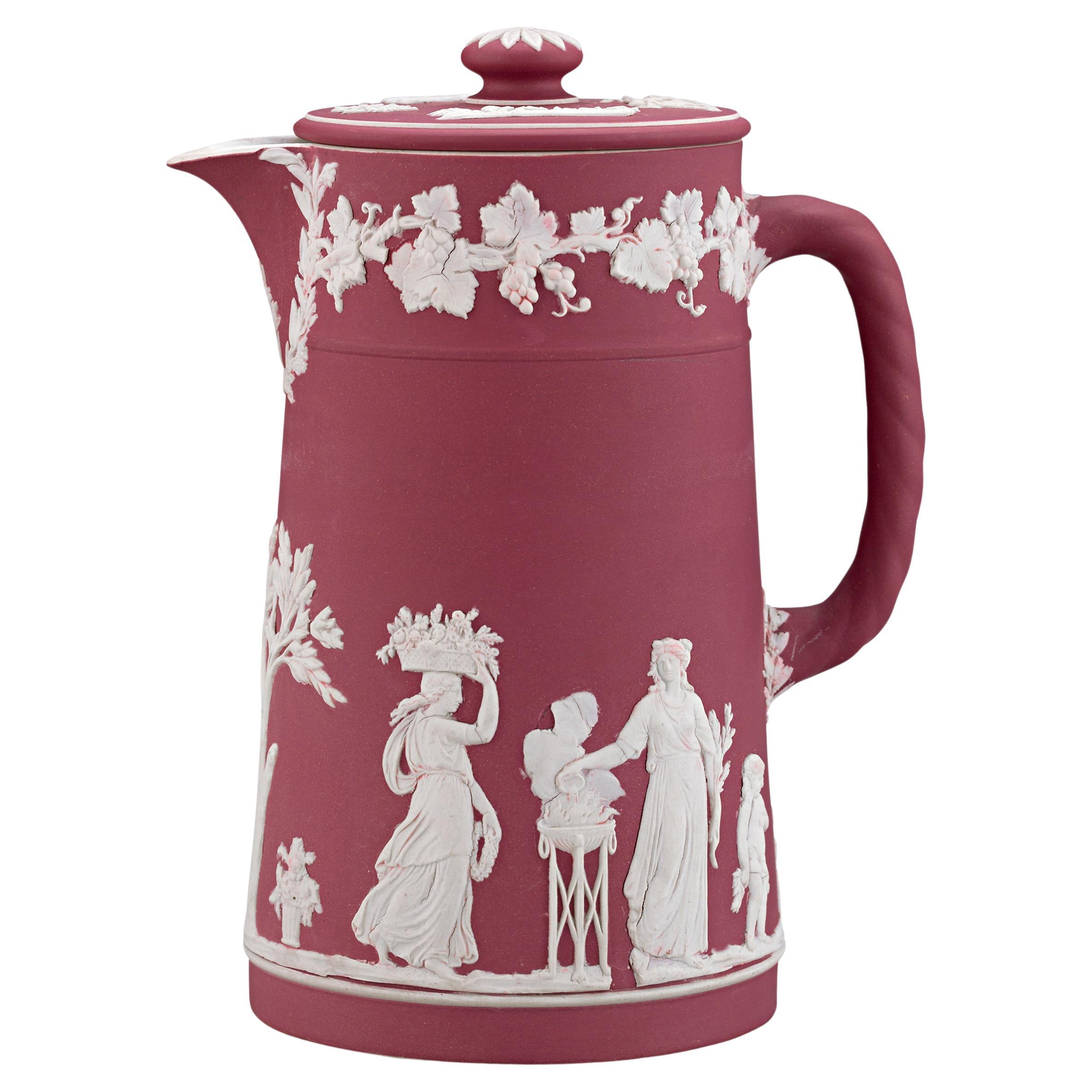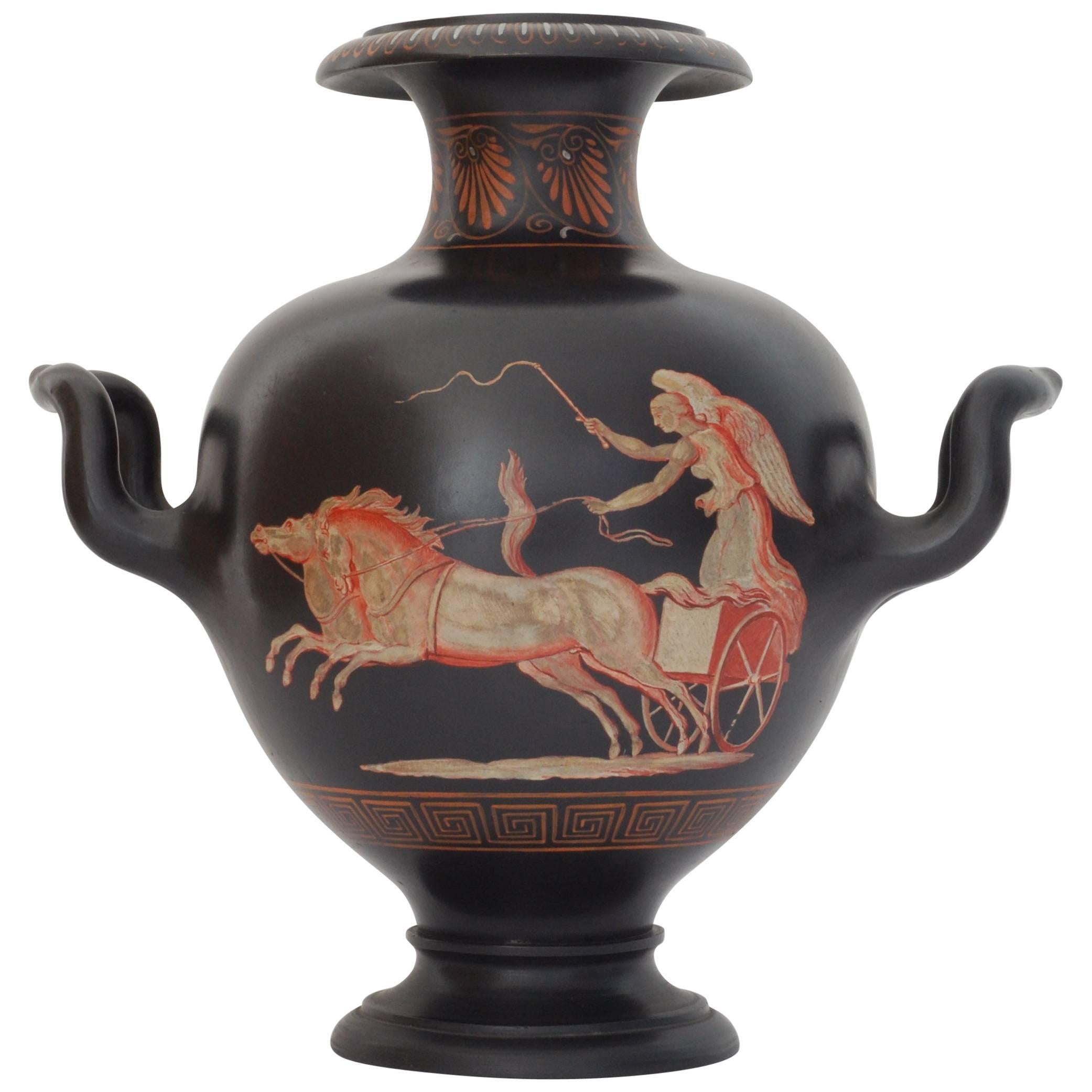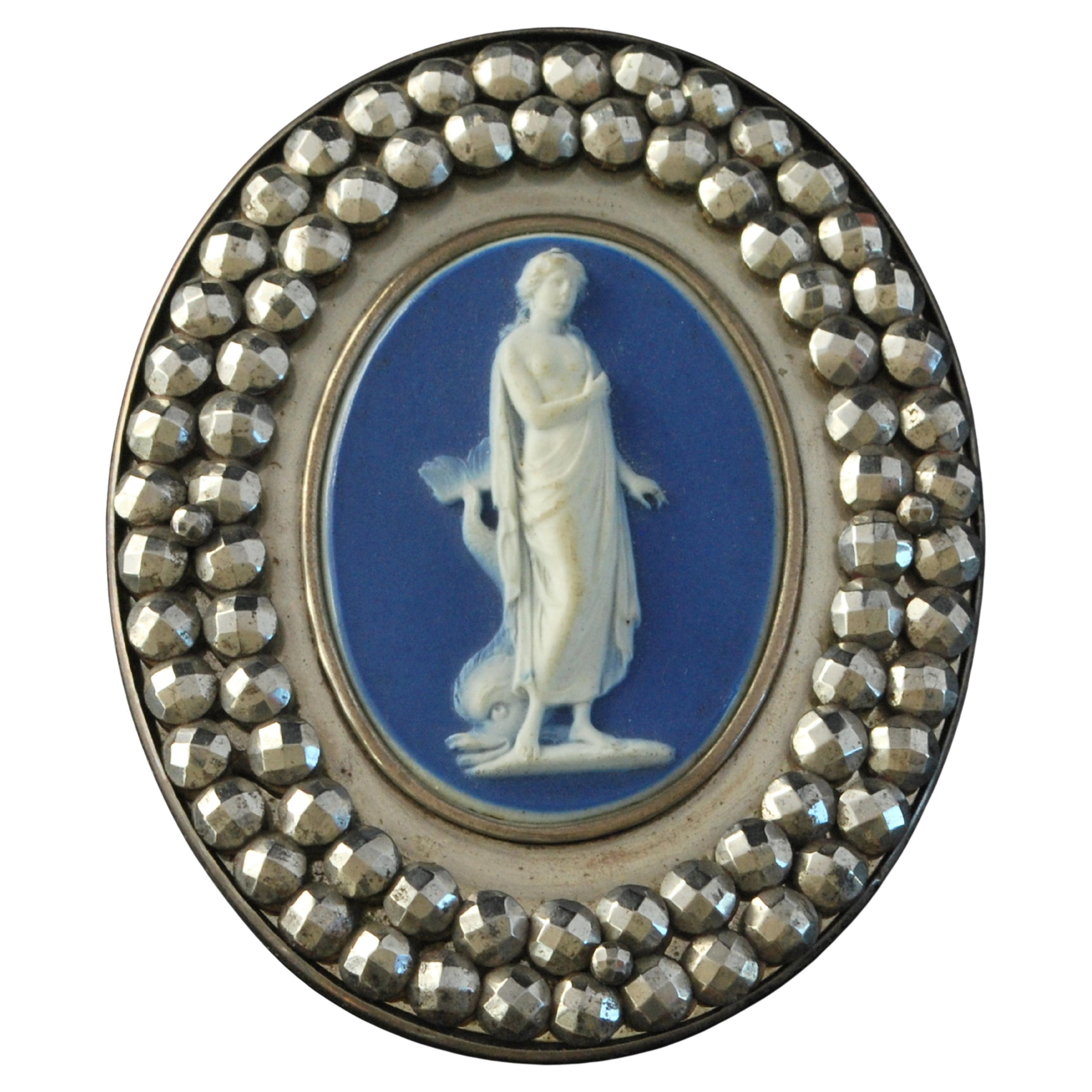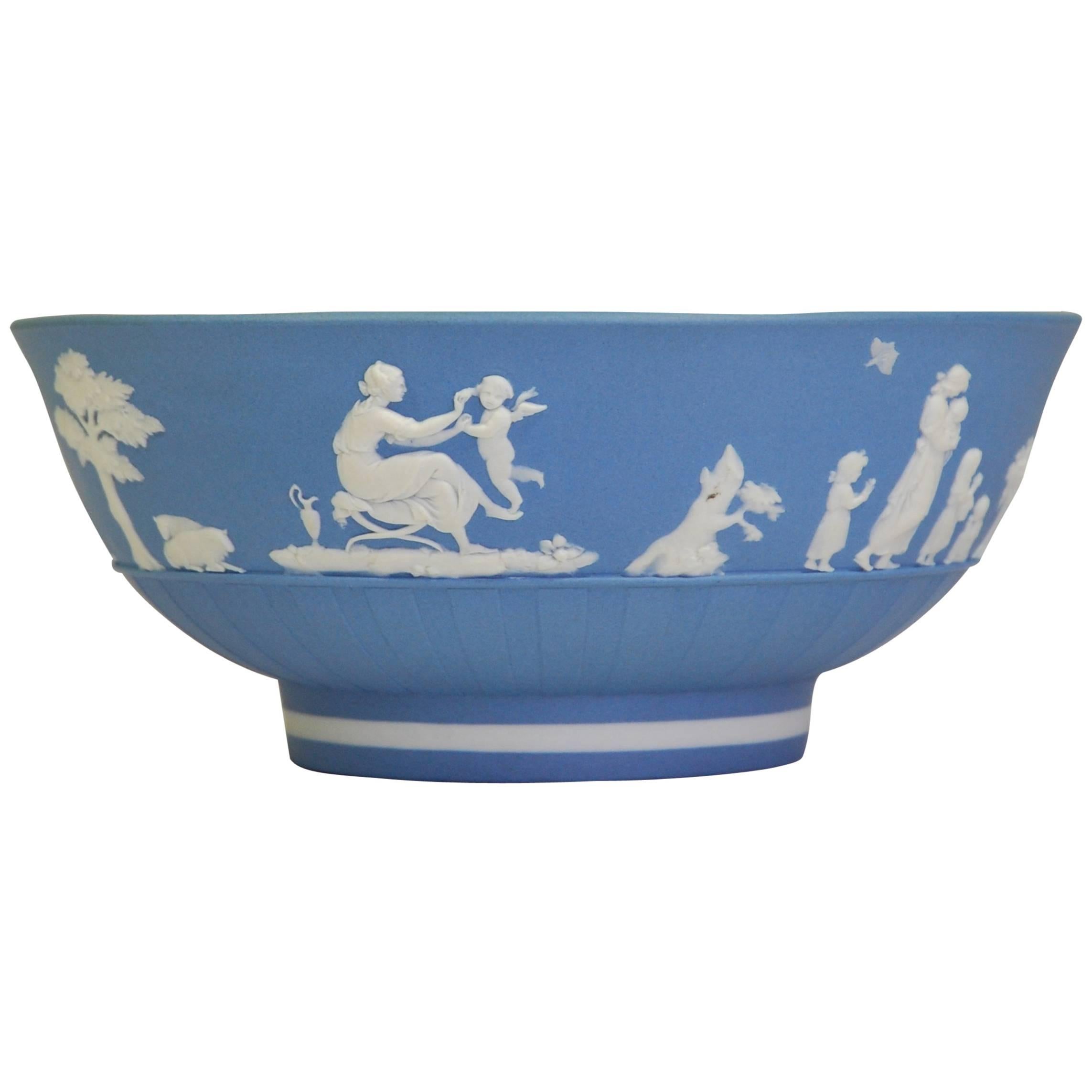Hot Milk Jug, Engine-Turned Jasperware. Wedgwood, C1785
About the Item
- Creator:Wedgwood (Manufacturer)
- Dimensions:Height: 5.5 in (13.97 cm)Diameter: 3.5 in (8.89 cm)
- Style:Neoclassical (Of the Period)
- Materials and Techniques:
- Place of Origin:
- Period:
- Date of Manufacture:circa 1785
- Condition:Lacking cover. The jasper has sunk slightly under the spout; this happened in the kiln.
- Seller Location:Melbourne, AU
- Reference Number:
Wedgwood
Arguably the most celebrated of all English ceramics makers, Wedgwood was founded in 1759 by Staffordshire potter Josiah Wedgwood (1730–95). The company is famed for its Jasperware — molded Neoclassical stoneware vases, plates and other pieces, inspired by ancient cameo glass, featuring white figures, scenes and decorative elements set in relief on a matte colored background. The best-known background hue is light blue, but Wedgwood’s iconic silhouettes also appear on green, lilac, yellow, black and even white grounds. Some pieces use three or more colors.
The Wedgwood firm first came to prominence for its tableware, which quickly gained favor in aristocratic households throughout Britain and Europe. In 1765, Wedgwood was commissioned to create a cream-colored earthenware service for Queen Charlotte, consort of King George III. The queen was so thrilled with her new china that Wedgwood was given permission to call himself “Potter to Her Majesty,” and the decorative style became known as Queen’s Ware. Not to be outdone, Catherine the Great of Russia commissioned her own set of Wedgwood china in 1773. Nearly 200 years later, the firm created a 1,200-piece service for the coronation of Queen Elizabeth II. In recent years, leading designers including Jasper Conran and Vera Wang have collaborated with Wedgwood — in the tradition of such distinguished 18th century artists such as the painter George Stubbs and metalsmith Matthew Boulton.
From plates and other dinnerware to decorative items like urns, cachepots and candlesticks, Wedgwood designs lend a traditional air to Anglophile interiors. And even if you have to make your own tea, you may find it comforting to sip it from a delicate cup that was manufactured in the same Stoke-on-Trent kiln that produced Her Majesty’s tea service. Be sure to keep your pinky raised.
- ShippingRetrieving quote...Ships From: Melbourne, Australia
- Return PolicyA return for this item may be initiated within 14 days of delivery.
- Encaustic Painted Basalt Vase, Wedgwood, circa 1785By WedgwoodLocated in Melbourne, VictoriaPolished basalt, decorated with Victoria, Goddess of Victory, in her chariot; possibly after a Roman model such as the wall paintings at Herculaneum. T...Category
Antique 1780s English Neoclassical Pottery
MaterialsStoneware
- Creamware Portrait of Shakespeare, Wedgwood, circa 1785By WedgwoodLocated in Melbourne, VictoriaA style of portrait previously unknown, this extraordinarily deep bust of Shakespeare is in creamware, with a cold painted background. William Sha...Category
Antique Late 18th Century English Neoclassical Pottery
MaterialsEarthenware
- Jasperware Buckle, Wedgwood, Matthew Boulton, Circa 1795By WedgwoodLocated in Melbourne, VictoriaA jasper medallion decorated with Aphrodite, set in cut steel as a buckle, probably by Matthew Boulton. Original box. The Greek goddess Aphrodite is often depicted in ancient art with a dolphin. In mythology, dolphins were considered sacred to Aphrodite, and they were associated with love, beauty, and fertility. According to one legend, Aphrodite emerged from the sea on a shell-borne chariot drawn by dolphins, and the creatures were said to be her faithful servants. As a result, images of Aphrodite with dolphins became a popular motif in Greek art, appearing on vases, sculptures, and other decorative objects. The association between Aphrodite and dolphins has continued through the centuries, and the image of the goddess with a dolphin remains a popular symbol of love and beauty. Matthew Boulton (1728-1809) was an English manufacturer and entrepreneur who was best known for his contributions to the Industrial Revolution...Category
Antique Mid-19th Century English Neoclassical Pottery
MaterialsCut Steel
- Potpourri in Cobalt Jasperware, Wedgwood, circa 1820By WedgwoodLocated in Melbourne, VictoriaA broad, flat potpourri in cobalt jasper dip, with a tall pierced cover.Category
Antique Mid-19th Century English Neoclassical Pottery
MaterialsPottery
- Pale Blue Jasperware Bowl, Wedgwood, circa 1790By WedgwoodLocated in Melbourne, VictoriaIn solid slate blue jasper, with inlaid foot; decorated with numerous reliefs typical of the period. Engine turned decoration and lapidary polished interior. Exhibited: Wedgwood, Ma...Category
Antique 1790s English Neoclassical Pottery
MaterialsStoneware
- Pair of Salts in Slate Blue Jasperware, Wedgwood, circa 1790By WedgwoodLocated in Melbourne, VictoriaA pair of salt cellars in slate-blue jasperware, with inlaid rims. decorated with the Romantic Poor Maria and Maternal Affection by Lady Templetown, as well as a more classical Cupid's Triumph. In the 1790s, salt cellars were an essential tableware item used in England for serving and consuming salt. A salt cellar is a small container, often made of silver, glass, or porcelain, used to hold salt at the dining table. These cellars were typically placed in the center of the table, within easy reach of diners. Salt was taken from the cellar...Category
Antique Late 18th Century English Neoclassical Pottery
MaterialsStoneware
- Wedgwood Crimson Jasperware PitcherBy WedgwoodLocated in New Orleans, LAThis striking Wedgwood crimson dip bas-relief covered jug features an applied white jasper neoclassical decoration of grapevines bordering the rim. De...Category
20th Century English Neoclassical Pottery
MaterialsPottery
- Wedgwood Creamware Platter or Charger 18th Century Made in England Circa 1785By WedgwoodLocated in Katonah, NYThis Wedgwood creamware round platter or charger was made in 18th century England circa 1785. The border is decorated with a traditional neoclassical design of iron-red flower heads...Category
Antique Late 18th Century English Neoclassical Decorative Dishes and Vid...
MaterialsCreamware
- Wedgwood Pearlware Fox Hunting Jug, circa 1810By WedgwoodLocated in Downingtown, PAWedgwood pearlware fox hunting jug, circa 1810. This ovoid jug has a cylindrical neck, a projecting lip, and a ribbed ear-shaped loop handle. Bat prin...Category
Antique Early 19th Century English Georgian Pitchers
MaterialsPearlware, Pottery
- Wedgwood Pewter Mounted Majolica Jug with Fruiting Vine PatternsBy WedgwoodLocated in Bishop's Stortford, HertfordshireA fine antique Wedgwood majolica pewter mounted pottery jug decorated with fruiting vines and with date code for 1860. The jug stands raised ...Category
Antique 1860s English Victorian Pitchers
MaterialsPottery
- Millie Taplin Art Deco Wedgwood Floral Painted Cream JugBy WedgwoodLocated in Bishop's Stortford, HertfordshireA very fine and stylish Art Deco Wedgwood floral painted cream jug by renowned designed Millicent (Millie) Jane Taplin (British, 1902-1980) and dating from around 1930. Millie was a renowned painter of ceramics who was trained by Alfred and Louise Powell and spent most of her career working at Wedgwood becoming one of the main designers at Wedgwood. The tall and elegant helmet shaped cream stands on a round pedestal base and made in a drab (cane ware...Category
Vintage 1930s English Art Deco Pitchers
MaterialsPottery
- English Engine-turned Creamware TankardLocated in Downingtown, PAEnglish creamware tankard, circa 1810-1820. The creamware tankard is decorated with a series of moulded engine-turned honeycomb designs separated w...Category
Antique Early 19th Century English Georgian Barware
MaterialsCreamware, Pottery






